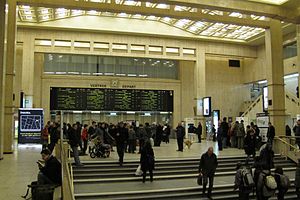Brussels-Central railway station
|
Brussels Central
|
|
|---|---|
|
|
|
 |
|
| Coordinates | 50°50′44″N 4°21′25″E / 50.84556°N 4.35694°ECoordinates: 50°50′44″N 4°21′25″E / 50.84556°N 4.35694°E |
| Owned by | National Railway Company of Belgium |
| Line(s) | North–South connection |
| Platforms | 6 |
| Other information | |
| Station code | FBCL |
| History | |
| Opened | 4 October 1952 |
 |
||||||||||||||||
| Owned by | STIB/MIVB | |||||||||||||||
| History | ||||||||||||||||
| Opened | 1976 | |||||||||||||||
| Services | ||||||||||||||||
|
||||||||||||||||
Brussels Central Station (Bruxelles-Central / Brussel-Centraal) is a metro and railway station in Brussels, the capital city of Belgium. It is the busiest railway station in Belgium and one of three principal railway stations in Brussels (See: List of railway stations in Belgium) First completed in 1952 after protracted delays caused by economic difficulties and war, it is the newest of Brussels' main rail hubs.
For a long time Brussels North and Brussels South were the primary railway stations in Brussels (Brussels North slowly supplanted the original Groendreef/Allée Verte Station near the same site). However, they were joined only by an inadequate single track running along what is today the route of the Brussels inner ring road. Many proposals were put forward to link the two stations more substantially before a law was passed in 1909 mandating a direct connection. Victor Horta was awarded the design of the Central Station building complex in 1910. He finished the initial version in 1912. The Putterie district began to be razed to make way for the underground station and building complex. However work was halted by the First World War. Financial constraints limited work after the war, and in 1927 the government suspended the project altogether. In 1935 a new office dedicated to the project was set up and work resumed. The Central Station was planned as a hub in the connection. However, the Second World War slowed construction again. The interruptions and delays to construction left large areas filled with debris and craters for decades. The station was finally completed in October 1952 based on a modified design by Victor Horta.
The railway station has six tracks, served by three island platforms. These are underground, beneath the city blocks within the "Boulevard de l'Impératrice/Keizerinlaan" (Empress Avenue), "Rue de l'Infante Isabelle/Infante Isabella straat" (Princess Isabella St.), "Kantersteen" (square stone) and "Rue de la Putterie/Putterijstraat" (Puttery St.).
...
Wikipedia
